I first “met” Keith Matejka when he was running a Kickstarter campaign to fund his first game “Bullfrogs” back in 2014. When he initially told me about Roll Player, I was fortunate enough to get my hands on a prototype and I immediately fell in love with the game. The moment he launched his Kickstarter campaign, I was hitting that “Back This Project” button without hesitation.
That Kickstarter campaign was a real nail biter. I remember watching the campaign crawl along and fretting that it wasn’t going to reach its funding goal. And then, just three days shy of the end of the campaign, it crossed the finish line and started knocking out stretch goals. That was in 2015 and if you’d asked me then, I never would have guessed that Roll Player would go on to become one of the most recognizable franchises in the hobby board gaming world. Since then Roll Player has gone on to spawn two expansions as well as several spin-off games that take place in the Roll Player universe.
It’s difficult to pigeonhole exactly which categorization the game fits into. At its heart, it’s a game about generating a role-playing character by rolling a bunch of dice, but it’s so much more than that. It’s got elements of set collection, worker placement, resource management, dice drafting, and some mechanics I don’t have any descriptive names for. Each player has a number of goals that they will be working towards and these goals, if met, will reward them with a variable number of victory points (called ‘reputation stars’ in the game). At the end, the person with the most points will win the game.
This is a very high level overview of the game. If you’re already familiar with Roll Player and just want to know what I think of it, feel free to skip to the Thoughts section. For the rest of you…
Setup
As you read this section, you may encounter some unfamiliar terminology. I promise you that as you read on, it will all make sense.
At the beginning of the game the players will roll a die to determine who gets first pick of the different Races. Then the other players will select from the leftovers. Each player then receives some gold to start the game with. Then they will draw dice from the bag and take the Class card that matches whichever color was drawn and choose a side to play with. Next, the players are dealt a Backstory card and an Alignment card and those are placed onto their character sheets in their proper locations. One player cube is placed into the middle spot of the Alignment card and one is placed onto the Backstory card.
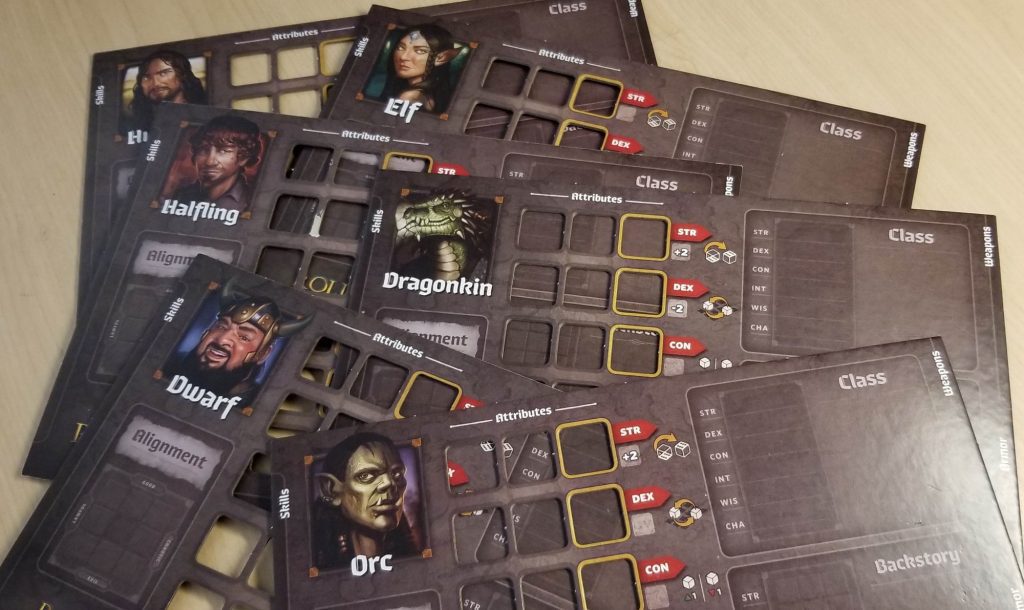
A starting player is determined and starting with that person, each player will take turns reaching into the bag and blindly extracting a certain amount of dice which are rolled and placed onto the character sheet in the leftmost position of whichever attributes the player chooses. No attribute actions are performed at this time. If any of the attributes has all 3 spaces covered, the players doing so will receive one gold apiece. If any players place gold dice onto their character sheets, then they will receive two gold per yellow die placed at this time.
Each player’s character sheet will look something like this:

Then the Market is set up. A number of Initiative cards, based on player count, are placed into the center of the table along with an equal number of face up Market cards drawn from the top of the Market deck. Any Initiative card that is not the first or last card will then have a gold token placed on top of it. With this completed, you are ready to begin playing.
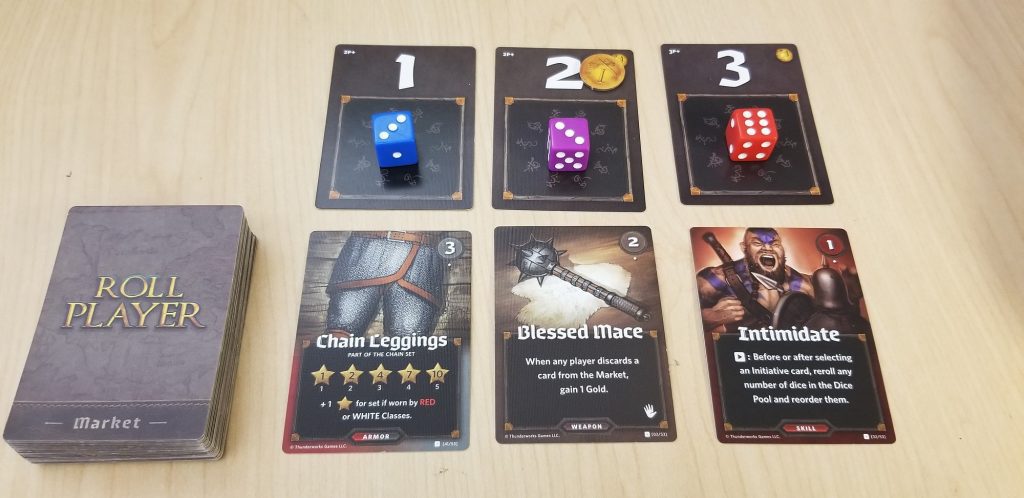
Round Overview
The number of total rounds in a game of Roll Player varies depending upon the total player count, but the actions performed during the round are always the same.
First, the starting player will randomly draw a number of dice from the bag equal to the number of Initiative cards and then roll them. These dice are then arranged in numerical order and placed in order onto each of the Initiative cards. Then, beginning with the starting player, each player takes turns selecting one of the dice and taking the die into their control and placing their unused player marker onto the Initiative card the die was removed from. Each player then places the chosen die into one of their attribute rows on their character sheet and performs the associated attribute action if they so wish. Once this is complete, it’s time to go shopping.
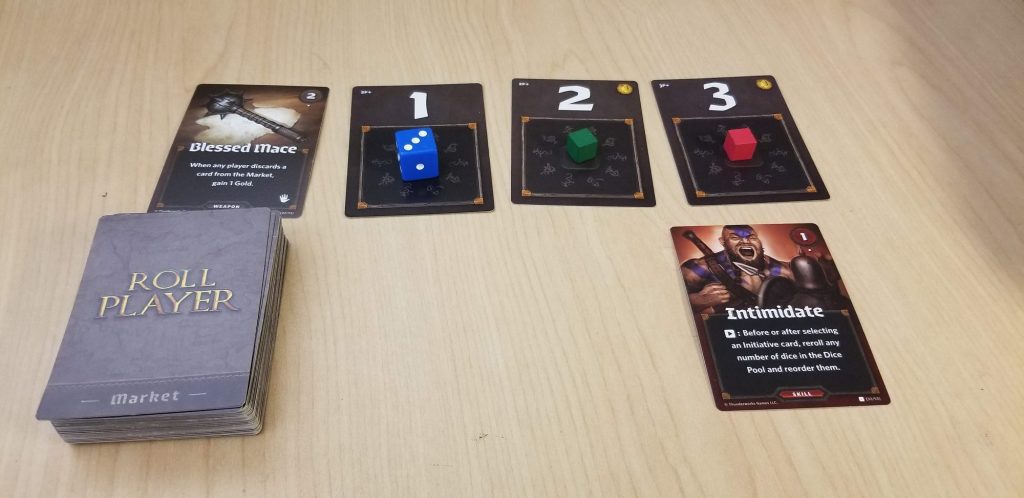
In turn order (determined by the Initiative cards), a player may choose to purchase any one of the cards that are available OR they can discard one card from the lineup and take 2 gold instead. The type of the card purchased will determine where the card is placed along the edge of the character sheet and also when and how often the card can be used. Then the player markers are returned to the players, the remaining dice that were not selected are placed back into the bag, and the cards remaining in the market (along with any unused Charisma tokens) are discarded. Finally, gold is placed onto the proper Initiative cards, each player may refresh any one of their exhausted Skill cards (more on these momentarily), and the bag of dice is passed to the next player in line who becomes the starting player for the next round.
Character Goals
As mentioned in the overview, each character has certain goals that they are trying to accomplish and the attempt to meet these goals is achieved through the placement of the dice onto the character sheets into the attribute rows. Each character sheet shares the following aspects:
Alignment cards – the ultimate goal of the Alignment card is to manipulate the alignment cube using acquired Skills and the Wisdom attribute so that it ends up on one of the positive reputation star spots at game’s end and preferably not one of the negative ones.
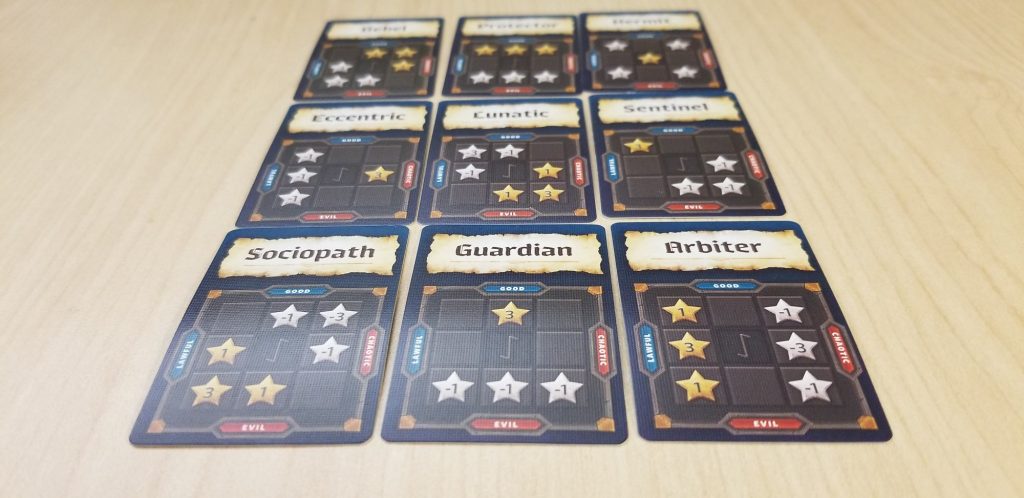
Class cards – each character class features a unique card which dictates a numerical range that the total of the dice played into each attribute row should fall into by the end of the game as well as how many reputation stars the player will earn if they manage to meet these criteria.

Backstory cards – the Backstory cards provide an interesting backstory for your developing character. The left side of the card displays each of the six different attributes, but instead of displaying target numerical values, each one of these has three squares to the right of it and one of these squares has a particular color that coincides with the colors of the various dice. The more colors that are in the exact locations at the end of the game, the more reputation stars they will be worth.
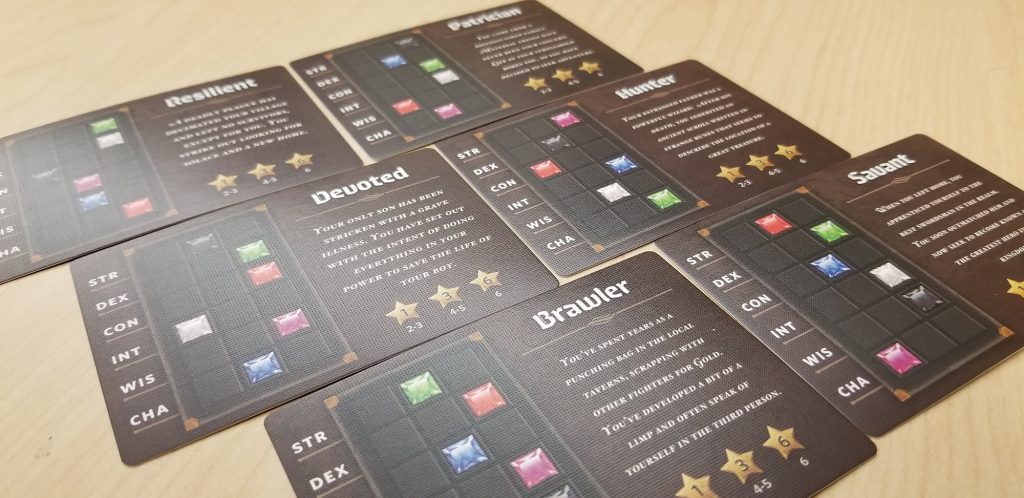
Each character sheet shows six different stats – strength, dexterity, constitution, intelligence, wisdom, and criteria. Each of these attributes has an associated action. Those actions are:
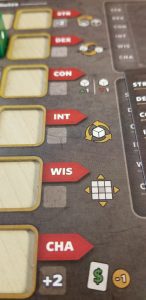 Strength – any die placed in this attribute will allow the player to change the face of a single die on their character sheet to the face on the opposite side of the die.
Strength – any die placed in this attribute will allow the player to change the face of a single die on their character sheet to the face on the opposite side of the die.
Dexterity – any die placed in this attribute will allow the player to swap the placement of any two dice on their character sheet without changing the values.
Constitution – any die placed in this attribute will allow the player to increase or decrease the value of a single die anywhere on the character sheet by 1.
Intelligence – any die placed in this attribute will allow the player to choose any die on their character sheet and re-roll it.
Wisdom – any die placed in this attribute will allow the player to move the player cube on their Alignment card up, down, left, or right by one space.
Charisma – any die placed in this attribute will allow the player to take one of the Charisma tokens into their possession. This token can later be used to decrease the cost of an item purchased in the market by one gold.
Filling in the last spot on an attribute row will earn a player 2 gold pieces and using a yellow die will always earn 1 gold piece regardless of where it is placed.
The Tools of the Trade
A role-playing character is more than just the sum of their stats, though. A wizard isn’t a wizard without a retinue of spells and a rogue isn’t very rogue-like if he isn’t wielding a dagger and sneaking around in the shadows. These are the elements that breathe life into the spreadsheet that our characters are built around and these are the kinds of things that you will find for sale in the market. Each market card has a cost that is paid for in gold. There are four types of market cards to choose from:
Skill cards – allow the player to perform special actions by “exhausting” the card (turning the card sideways), moving their Alignment cube in the direction specified on the Skill card, and then doing whatever the card says. These cards can be used as soon as they are purchased or they can be saved for a later time. If the player is unable to move their Alignment cube in the correct direction, then the Skill card cannot be used.
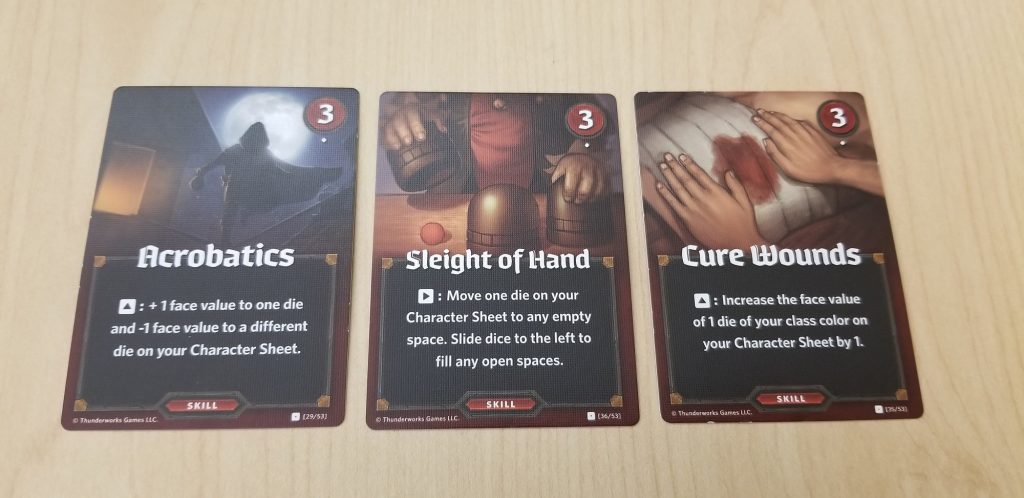
Weapon cards – also provide the player with benefits. Each weapon has a number of hand-shaped silhouettes on it. At no time may a player have more than two hands worth of Weapon cards unless they have some ability that tells them otherwise.
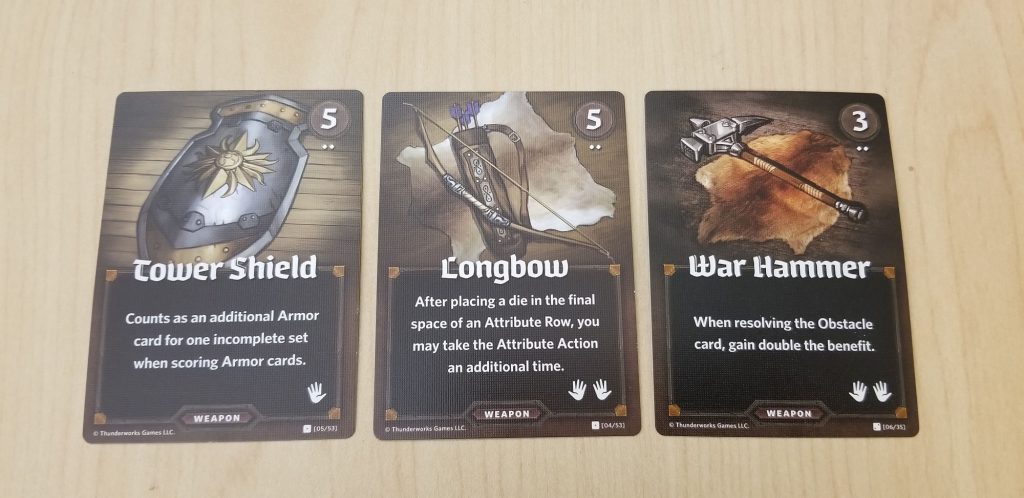
Armor cards – do not provide any noticeable benefit during the course of the game. However, at the end of the game, they are worth a variable amount of Reputation points depending on how many of a certain set that you have collected… and you’re not limited to collecting just one set. You can try to collect them all if that’s what you want to do.
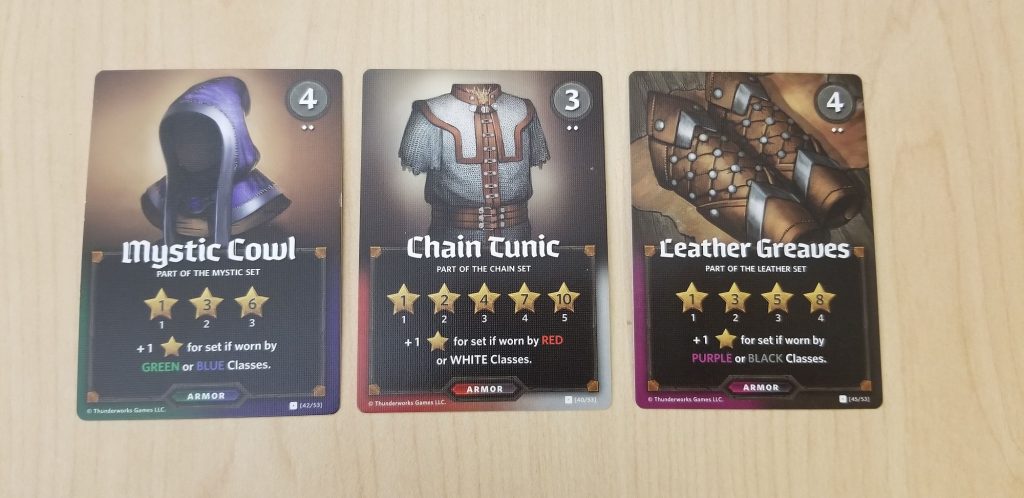
Trait cards – will provide additional bonus Reputation stars at the game’s end providing that the certain conditions that are laid out on the card are met. Since these cards provide some sort of ongoing effect, it is never necessary to exhaust these cards.
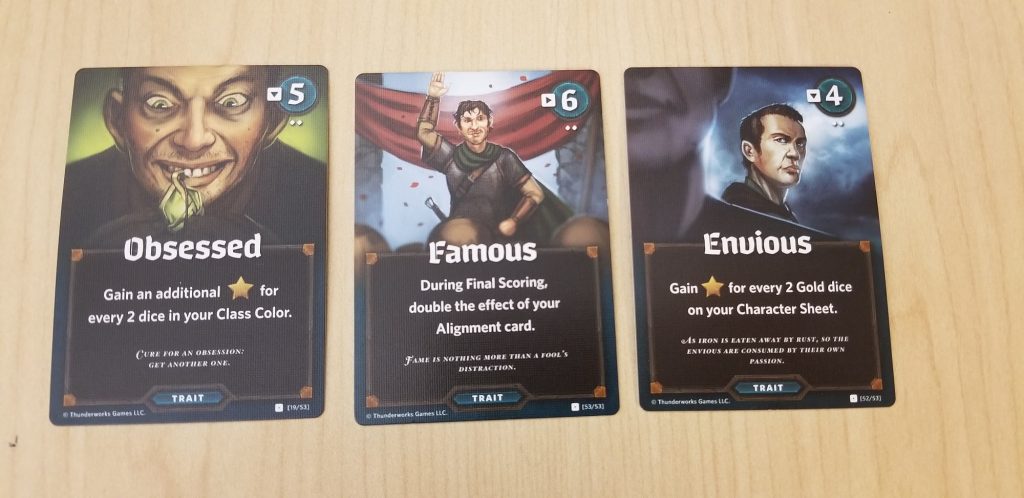
The Endgame
When every player has filled their last attribute spot on their character sheet the game ends. At that time the reputation points gained from the Trait cards, Class cards, Backstory cards, Alignment cards, and Armor cards are tallied. Each die on a player’s character sheet that matches the player’s class color is worth an additional reputation point each. Once each player has counted up their points, the point totals are compared and whoever has the most points is the victor!
Thoughts
The world of role-playing games has changed considerably in the twenty or so years that I have been playing them, but one thing has always remained consistent throughout that time period – rolling characters and having to pore through fifty different books is BORING. Well, Roll Player takes that process and turns it into something fun that I wouldn’t mind doing time and time again. I just wish there were an actual game system that used this as their character generation mechanic because it would instantly become my favorite game system ever. Roll Player is just that good!
One would think that a game that is primarily comprised of a lot of dice rolling might lack any form of strategy, but Roll Player would prove them wrong. At every turn the player will find themselves faced with agonizing decisions. The more dice that get placed onto the character sheet, the tougher moving or changing any previous placements becomes, so thoughtful dice placement is critical if you want to have any hope of winning. This becomes even more pronounced when you add in the Class cards and Backstory cards. These cards are worth a ton of Reputation points at the end of the game and a player will ignore them at their own peril.
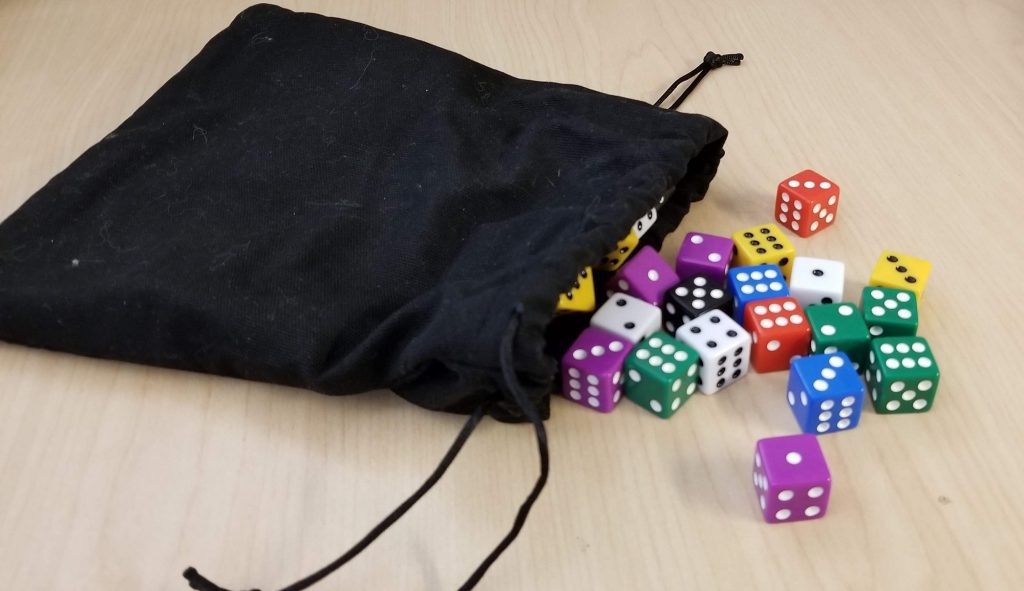
Additionally, the introduction of attribute abilities provides a clever method for the players to negate lousy dice rolls. These abilities create a plethora of options that must be weighed carefully to ensure that each die that is placed is being placed as effectively as possible. There have been multiple occasions where I find myself deep in thought, hand poised above the character sheet with a die in hand, second guessing myself every time that I thought I’ve figured out the best place to put it. Do I want to go for the Backstory bonus or would the die be put to better use trying to reach one of my attribute goals? Or should I fill up an attribute row to get some gold, but forever deny myself further use of that attribute’s action? How badly do I need that action to be available later should the dice come up less than favorably for me? It is this constant decision making and strategizing that keeps this game exciting and entertaining.
Each time I break out this game, it’s a hit. Everyone has a great time and almost every time, someone will make a comment that they wish there were more… that they wish they could take the character they’ve spent the last thirty minutes to an hour constructing on some kind of follow up adventure. Fortunately for them, there’s the Monsters and Minions expansion, but that’s a story for a different day!


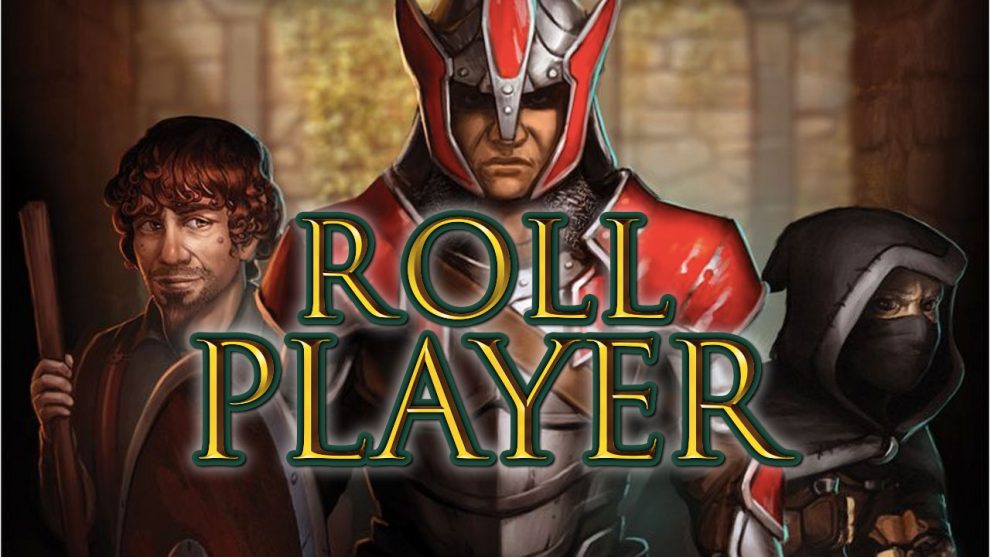


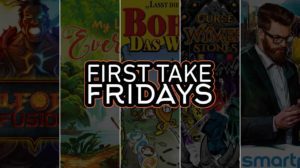
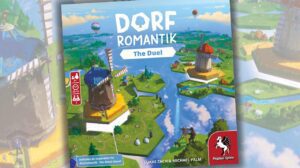





I have not played this game, but I think I would spend all the money for an IoS version!
If you’re ever in the Nashville area, I’d gladly play it with you.